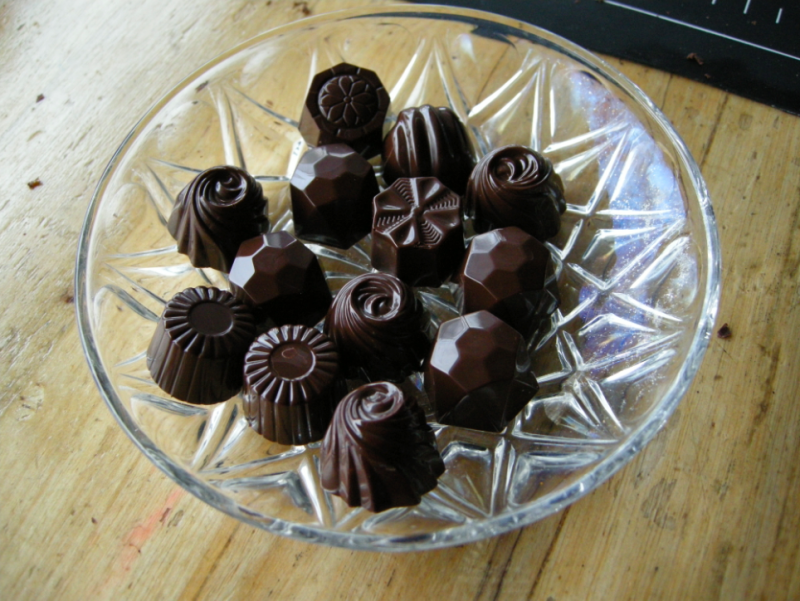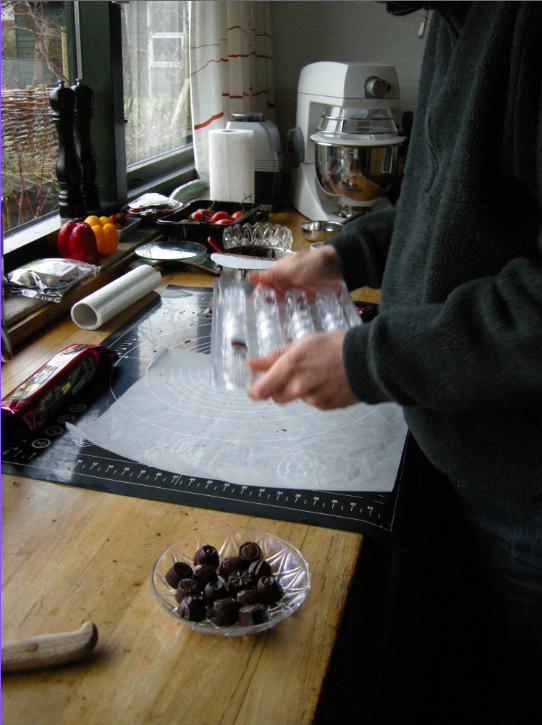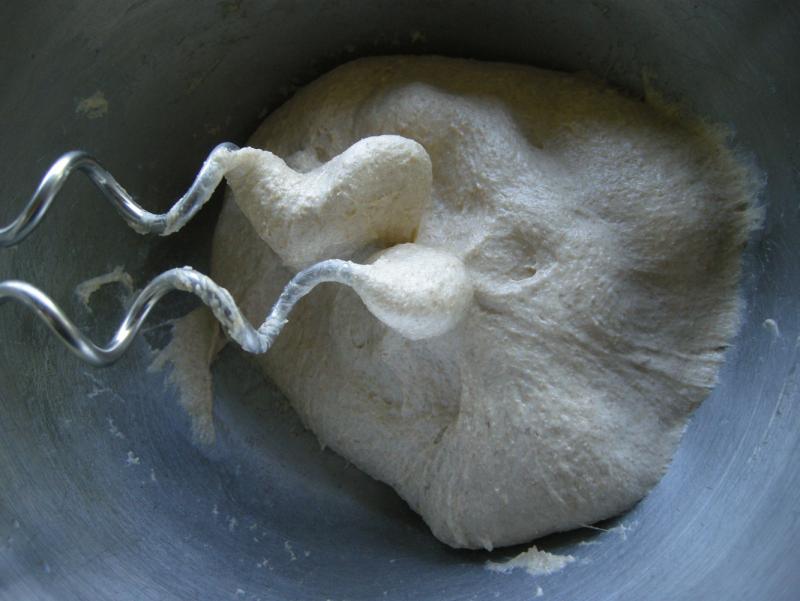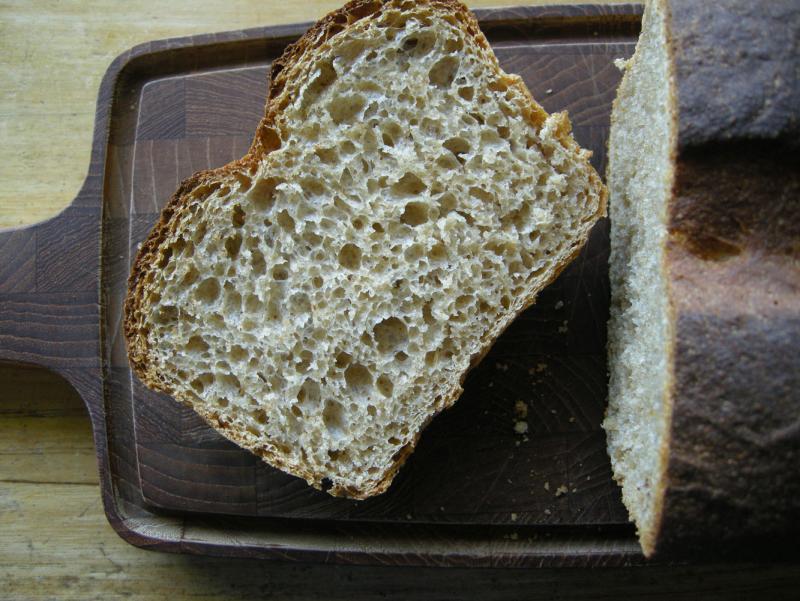-
Posts
7,674 -
Joined
Content Type
Profiles
Forums
Store
Help Articles
Everything posted by Mjx
-
The scenario is an impossible one. Anyone who knows me is well aware I would have seen the kitchen and the prep process long before eating and the conversation. I also do not tend to socialize with people that are into producing dishes based on Modernism or Molecular Gastronomy or Avant Garde cuisine in their -homes-. They don't typically pass my sniff test as people I want to be associated with because they aren't down to earth enough. . . . . Please clarify what you mean when you say 'Modernism' and 'Modernist'. I have a very clear idea of what I mean by 'down to earth' and 'Modernism' (respectively, 'practical and grounded in reality' and 'the pursuit of an understanding of how food works, the exploration of the available means for achieving desired results in the kitchen, and the application of both to get the best possible results when cooking'). I suspect we're having a discussion about two entirely different things; you've exclusively expressed your distaste for certain equipment and ingredients, when those are merely the means to certain (by no means all) ends, and many of today's Modernist ingredients and equipment will be obsolete or mainstream in 100 years, just as those newfangled blenders and prepared pectin were, decades ago. What could be more 'down to earth' than applying an intelligent understanding of food to its preparation? Virtually all the discussions of Modernist cooking appear in dedicated threads, where you'll find a distinct absence of dismissiveness of tradition or those who favour this (not least because most people's enthusiasm for Modernism has nothing to do with rejecting what already exists). If some people's enthusiasm for Modernism (probes, water baths, whippers, and all) is annoying, why go out of the way to read threads dedicated to these very topics, whether they're about techniques, restaurants, or sources of materials, when there are heaps of other topics and discussions to explore? If I'm entirely uninterested in a topic, I just don't bother looking at discussions of it. It would never even cross my mind that these discussions shouldn't exist because they don't interest me.
-
What?! Why would traditionalists hide in the closet?! Those who are interested in Modernism are running amok? And Modernism has no business in the home kitchen?! Seems a bit draconian and unfair, besides... Okay, hang on, let's take this scenario: You're invited to dinner, you really enjoy the food and conversation, then, after dinner, while your host is moving the last of the dishes back to the kitchen, you tag along, since you're in the mddle of discussing something. You notice the kitchen has a lot of Modernist equipment, and inquiry reveals that the meal was prepared using quite a lot of Modernist techniques and ingredients. Would this suddenly ruin your evening (please understand that this is not intended as either snide or rhetorical)? Why should it matter how the food was prepared? Why must there be the assumption that it's either/or, Modernism or tradition (which, again, was once cutting edge in its own right)? I'm fascinated and excited by much of Modernism, but nothing makes me happier than the sight and scent of a bunch of chickens roasting on a spit in a colossal stone fireplace; I don't find this odd or conflicting, and none of those I know who are interested in Modernism seem to have insisted on planting their flag squarely in one camp either, it's just not how an appreciation of food works. Sure, extremists and snobs exist, but they always have (rememeber 'nouvelle cuisine'?), and who cares about them? They're having no fun anyway, and if there's been an uptick in resturants featuring Modernis cooking, there still remain plenty that are as traditional as they ever were. Let's make food, dammit, not war!
-
That... is why you fail. Never! An education is never a waste And now for something completely different: Although culinary extremism of any sort heads my list of disliked trends, the increasing difficulty in finding (at least in NYC) yogurt that is not fat-free runs a not-that-distant second. I have nothing against the fat free product as such, but I'd prefer to be able to make the decision on my own.
-
Exactly! Just a few more people using the techniques in (to us) interesting ways. This should (I'd hope) go without saying, and since part of the idea behind Modernism is to use the best techniques or ingredients, the traditional is not going to be discarded simply for not being the latest thing. There may be a better way of roasting chestnuts than to cut an X in their tops and pop them in an ordinary oven (I've had no luck with the open fire thing), but I haven't found it. Yet. Too late for us; we've settled in, and like it here! To quote the only fridge magnet I ever willingly bought, we heard 'Come to the dark side, we have cookies', and thought 'Fantastic', then looked at the recipe, and decided to fraction the butter, do distinctly different things to each fraction, recombine them and add them to the dough using carefully measured pressure, speed and temperature, then chilled, froze, thawed and formed the cookies, and are now planning to bake them in the microwave... to see what happens).
-
This is all absolutely fair and reasonable, BUT. There are people who find the idea of going amok with modern technology really relaxing, and there are those who are very detail oriented, who find fine-grained control soothing. We love the little gadgets that give us precise, accurate information! Being able to fine-tune a recipe feels really great! But none of this seems to directly conflict with more traditional approaches (today's low-tech was once state of the art); Modernism seems like an addition to what can already be done, not a replacement.
-
I've used grape seed oil with no problem at all, find it less gummy than the available flax seed oil (and more reasonably priced). In a pinch I've used all sorts of things (rather than leave the bare iron vulnerable and exposed; an oil that gums is a drag, but can be removed, unlike the pits caused by rusting).
-
I've read that the petits fours layers are supposed to be weighted, but there was no indication of how long, or how much weight is to be used; anyone have experience with this?
-
Yep Actually, yelling, no; holding forth at exhausting length, yes. Probably. This site seems to be a nexus for gastro-geekery. Personally, what I dislike about 'modernism' is that its practitioners define themselves as somehow apart and above gastronomy, when in actual fact the only fundamental difference is a self-consciousness about what happens to food at a molecular level. What's missing from modernist cuisine are such things as restraint, good-taste, knowledge of culinary history, vision and imagination. Hence so much of its output is characterised by the infantile appeal of brightly-coloured and over-flavoured pap. I can see its appeal for young and gastronomically ignorant technophiles, but credibility requires that the movement achieves a lot more than making stuff very, very soft. The only 'ism' that I can see as being intrinsically indefensible is 'extremism'. Why always 'my team or yours, enemies to the death'? Food extremism must one of the least attractive, yet persistent trends in the food industry. Why do you regard Modernism in cooking as being at odds with 'such things as restraint, good-taste, knowledge of culinary history, vision and imagination' (N.B. I'm capitalizing this simply to indicate that this refers to 'modernism as a cooking approach', rather than the broader philosophy)? Please identify three examples of 'brightly-coloured and over-flavoured pap'! The Modernism I'm familiar with almost obsessively pursues a diversity of flavours, not to mention, 'over-flavoured pap'?! Pap is implicitly bland (trust me to know this, I spend most of my time in Denmark), so this just seems an oxymoron. A sense of being 'apart and above gastronomy, when in actual fact the only fundamental difference is a self-consciousness about what happens to food at a molecular level'? How so? I see an enthusiasm for understanding how things work, for being enthusiastic over sweating the details, even when the end result is soup dripping from the ceiling and a partial spoonful of some really intense reduction. Can we bore people to death with a blow-by-blow of a 56-step process? Well, yeh... sorry about that. But that's hardly snobbery. The kitchen is our lab. There's no denying the geekery, but the people who seem most drawn to Modernism as an approach tend to be equally geeky (science/technology) in other parts of their lives; I'm just not seeing some sort of universal snobbery. Can there be a sometimes perplexing tendency to vacuum seal/cook everything sous vide? Yep. But I again, I don't see snobbery, I see geekery and a fondness for pushing buttons. There's more to Modernism than cooking things sous vide. Are there snobs who are drawn to Modernism? I don't doubt it, but I haven't come across them yet. Could that be because I'm so grotesquely snobbish that I don't recognize snobs when I see them (not a day goes by that I don't ask myself that very thing, but I don't think that's the case, at least, not the part about not recognizing snobs)? Did I mention the kitchen is our lab? It is, but we tend to have taste buds, and not infrequently, the desire to recreate something wonderful we once had, by any means available. Today, the available means include an incredible range of ingredients (including a fantastic array of once beyond-reach imports) and technology. Miss the amazing mortadella you had in Bologna on your honeymoon, and depressed by the local offering which taste of nothing? With access to various works on Modernism, you can have a crack at this yourself, having carefully furnished yourself not only with the knowledge to accomplish this, but also with the crucial information you need to ensure you create something delicious, rather than an outbreak of food poisoning. I grew up in Florence. My favourite foods are very simple and traditional, and many of these items were first created using cooking methods that are no longer easily available (cooking in embers overnight doesn't work out so well in today's flats), making today's results often inconsistent/unsatisfactory, or are mostly made commercially, and not necessarily what they were when I was a kid; and dammit, I'd like to be able to drink chinotto soda that is not so bloody sweet. When you dig into the physics and chemistry of food, you have the opportunity to not only create modern flight so fancy, but to find alternate routes to traditional favourites. Modernism as an approach is about 'This is what we can do, now', and the breadth of what this involves is vast. What it does not implicitly involve is a rejection of tradition, history – have you see some of the most significant works on Modernism, and the amount of history that is discussed? – vision, or imagination – take a look at the array of imaginative, lovely, and delicious-looking Modernist dishes posted in the lunch and dinner threads. I do understand that enthusiasm can be wearing, and that there are those who have embraced Modernism as an aesthetic/credo, but to dismiss it as an approach make no more sense than dismissing the widespread use of the food processor and gas/electric stove because 300 years ago everyone was using open flame. We are here, now, and we cook accordingly
-
My boyfriend is beaming, and says Thanks! The fillings are Danish marzipan (i.e. no bitter almond scent, and fairly coarsely ground), and a sort of solidified Nutella. My boyfriend candidly admits that these aren't particularly nice to eat (and asked me to mentionthis); most of them are still sitting in their chaste little glass dish, something almost unheard of when we're about. While I sat with about with five tabs open to various detailed discussions of chocolate in these forums, paged through Elements of Dessert for worthy filling ideas, and compared prices at online chocolate sources, my boyfriend sailed in, bought some cheap 'vekao' coating chocolate coins and supermarket 'gianduja' and marzipan, and actually did something, namely, these (he was also the one who grabbed at the chance to purchase three polycarbonate moulds on sale, and bore them triumphantly home). He did a second batch with these same moulds and a slightly better, actual chocolate product, but these only came out of the moulds after an hour in the refrigerator, so I'm guess the chocolate was not quite in temper..? I'm still looking at chocolate filling recipes.
-
First attempt at moulded chocolates: Here, the more adherent pieces are being loosened via the traditional Smacking of the Mould:
-
I don't even get as elaborate as that; I just pop a cast iron pan in the oven, preheat the oven, then, when it's come to temperature, put in the bread, fill the pan with boiling water (an oven mitt is a good idea), and close the door. Works every time. Doesn't look as gnarly as a bunch of rocks and chains, or have the entertainment value of a super soaker, but I survive these privations
-

Single burner induction cooktop with easy temperature adjustment?
Mjx replied to a topic in Kitchen Consumer
Okay, I'm not getting this: I know these are significant issues with the old-fashioned coil burners, but surely no one buys those anymore, and any decent glass ceramic cooktop heats evenly over the entire burner surface and has relatively fine control; the completeness of the contact area is dependent on the bottom of the pan being even (but only an open flame is forgiving of warped pans). I'm starting to think we're talking about two entirely different kinds of glass ceramic cooktops/burners. -
Tell us your secret, Michaela . Eh. It's just the skeleton of their sandwich bread recipe, which I posted about back in July:
-

Traveling... what condiments should I bring back?
Mjx replied to a topic in Food Traditions & Culture
Word of warning regarding anything that is jarred or bottled: the TSA is well with in its rights when opening any and all items of that sort, and they don't always re-close containers properly (or at all). I had one aggravating mess involving a bottle of shampoo was opened, and then just tossed back into my suitcase without being recapped. The oil from anchovies or the like would have to be exponentially worse, so you might want to keep this in mind, when you're packing for the homeward journey. -
I make bread from high-hydration dough on a regular basis (in fact, I make little else), because I love the finished consistency of the bread. I tried kneading this stuff by hand exactly once. I then switched to mixing loop, which gave great results (and great arms), but the wire broke, which is when I switched to a handheld mixer with dough hooks. I just combine all the ingredients in a large bowl, let it sit 20 minutes (a sort-of autolyse; the yeast is in there, too), then go at it with a the handheld mixer. Then I let it rise (I seldom give the dough a long rise), transfer it to a pan (or banetton, if I'm going to be doing this in the Dutch oven), give it a second rise (alsoo usually short and at room temperature), and bake it. The results are inevitably good; I adapted an America's Test Kitchen recipe, and they're very reliable. Longer rises give even better results with a more complex flavour, but usually, my boyfriend casually mentions we're almost completely out of bread, so I end up making it at the last minute.
-
Your selection is pretty much what you see at a Danish student party, and honestly, if it's just a question of mixing drinks for that crowd, I'd buy a couple bottles of seltzer and a couple of limes, and just... experiment You cannot possibly go wrong, unless you run out of booze before everyone is drunk enough to start dancing. On the other hand, if you're interested in developing your mixed drinks skills, the advice offered by everyone else is sound. If you want to see how a couple of other cocktail novices approached this, there the Help for a Couple of Cocktail Novices topic. If you want to look at some focused and advanced discussions, check out the topics in the Spirits & Cocktails listing, especially (since you have these spirits) the Tequila Cocktails, Scotch Cocktails, and Vodka Cocktails discussions.
-
It's a mood (and a bit weather) related thing; when things are warm and sunny, I appreciate pureed soups, but when it's cold, dark, and stormy, I like texture and substance (unless my throat is being ripped raw by a strep thing, then 'texture' reads as 'torture').
-
eg? I'm afraid it was mostly stir fries, which I realize sounds dull, but for speed, flavour, variety, and freshness, it's really hard to beat. Plus, as I said, I do like to experiment, and if an experiment was a disaster, I wasn't stuck with a large quantity of awful or inedible food. I grew up in Italy, so pasta was a go to for quite a while, but an aggravated carbohydrate intolerance took that off the table for most days, leaving it as a treat for when I could afford to be comatose the next day. But it also scales well, and leaves a lot of room for experimenting.
-
I've always liked cooking just for myself! The food I prefer tends to lend itself well to small batches (or large batches that hold well), so I never gave much thought to the fact that I was cooking for one. The usual strategy was to make biggish batches of soup/beans, which would be my go-to when I didn't feel like bothering to stir-fry some meat and vegetables. I always stir-fried small amounts (I have a regrettably efficient metabolism) in a small suace pan, and tended to experiment quite a bit, since I tended to do this for breakfast, lunch and dinner. I seldom baked, because I've always tended to eat the whole [insert baked item name here] in one go, which is not great. Occasionally I'd break out and make something completely different, and just scale it down; if I couldn't scale, I'd skip it, or share it with friends. Best Thanksgiving dinner I ever had was just me, some fantastic venison, baby greens, and some sort of winter squash thing... can't remember what, it's a while ago now
-
Depends on the flavour and texture you want; roasting seems to give more robust, complex results, poaching, especially in fat, gives more delicate, subtle results.
-
First, the bananas point...I am not saying you are wrong about this, but my point is that this will never be settled because it is impossible to find a consensus on this issue, and Chinese are intensely regional. I have eaten in almost every one of those cities you mentioned and don't disagree that you can find good, everyday Cantonese food. I guess the focus of my post was on Cantonese food in China. In any case, the good Cantonese offerings in these places doesn't translate to me feeling that Cantonese is the best of all Chinese foods, nor does it show it to be the most simple or complex, it just offers me a good cheap meal... Yet they still have this saying in China: 生在蘇州, 活在杭州, 喫在廣州, 死在柳州 :-D Translation please? Online translators tend to make mincemeat of anything that involves metaphor/allusion, etc.
-
You might want to PM fellow member sjemac, in the Moose topic, which describes his butchering of a moose, and some of the things he did with the meat; his experience with working with moose seems pretty comprehensive.
-
The problem may simply be in the lack of a general agreement on the meaning of terms, but in my opinion (and this aspect of the discussion is highly subjective) when you make a decision, you're actively engaged. When you consider a a variety of restaurants, look over their menus, talk to others about them, and choose a place to eat, you're actively engaged in selecting where you dine. When you order, in most places, there are decisions involved (if the place has a set menu, then that decision has been made previously). The same holds true of the wine(s) you select, whether or not you have coffee, dessert. You don't just go into a restaurant and say, 'feed me', tell the waiter to just bring you what he or she deems best. You become involved. I don't know about other people, but if there's something interesting going on behind the scenes, I'll read about that beforehand, since I find context interest; basically, when I eat out, I think. This doesn't mean I believe I have the right to tell the chef what to do, but I do ask questions about items on the the menu (e.g. 'Does this come with a creamy sauce?', or 'I'm planning on having a fairly substantial dessert, is one of the main dishes particularly light?'). . . . . As for "You don't just go into a restaurant and say, 'feed me'" - another poster here commented that he does it all the time. :-) I do this too although only in certain places and/or as occasion arises. If you go to a Japanese place and request "Omakase" you are certainly asking the place to just "feed me" in effect, and I think many people do indeed do this, surrendering themselves to what the chef sees fit to provide - although some (better?) places would honor such requests only from regular diners where their preferences have become known to the chef or sushi itamae. At other places one would indeed be asking the chef to provide you with whatever he felt like feeding you. ;-) When a baby opens its mouth, it says 'feed me'. Its blind trust and absence of thought arise from the baby's more or less complete helplessness in this situation. But even babies quickly become active, expressing appreciation and distate, showing glimmers of thought, and learning the names of the foods they like best. I've never had a problem with set menus, but it seems impossible to express a suitable interest in the food or appreciation for the chef's efforts if all one does is passively 'feed'. There may be no conversation about the food (although this is rare, in my experience), but if the food has been prepared intelligently and interestingly, that calls for acknowledgement, at the very least. The bottom line is that the way people eat reflects the rest of the way they exist, which is going to exhibit the same variety as humans themselves. So, in the very same dining room you may have one party chatting with the chef about Pistachios in mortadella, yes or no?, while at an adjacent table, the party is simply sitting, and silently absorbing the exact same dish being analysed at the first table. As long as everyone is being polite and considerate, they're both fine.
-
I'd go with a flavouring oil, as others have suggested, and I've used very finely grated rind, too. I've also experimented with adding a little citric acid, to incorporate citrus's tartness, which you don't get from a flavouring oil (err on the side of too little, rather than too much, and keep notes). Citric acid doesn't dissolve into the chocolate, but remains distinct crystals. I made lime and clove truffles some time back, and the result was great: the tiny, scattered sparkles of tartness melt on the tongue a bilt more slowly than the chocolate itself, and really offset the scent of the lime. In Elements of Dessert, the recipe for aerated (aka 'bubble') chocolate calls for 400 g oil/2 kg dark chocolate (4 lb 6.4 oz/14.11 oz).
-
I also favour a low temp followed by high temperature sear for roasts, but I've found that if I deglaze the pan carefully before the sear, I get little or not smoke. Normally, however, sloth circumstances dictate that I just deal with the smoke.






